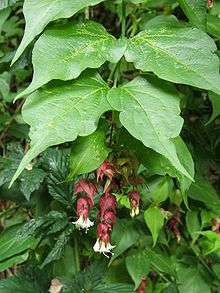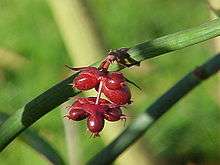Leycesteria formosa
Leycesteria formosa, the Himalayan honeysuckle,[1] flowering nutmeg, Himalaya nutmeg, granny's curls or pheasant berry, is a deciduous shrub in the family Caprifoliaceae, native to the Himalaya and southwestern China. It is considered a noxious invasive species in Australia, New Zealand, the neighbouring islands of Micronesia, and some other places.[2][3][4]
| Leycesteria formosa | |
|---|---|
 | |
| Leycesteria formosa foliage and flowers | |
| Scientific classification | |
| Kingdom: | Plantae |
| Clade: | Tracheophytes |
| Clade: | Angiosperms |
| Clade: | Eudicots |
| Clade: | Asterids |
| Order: | Dipsacales |
| Family: | Caprifoliaceae |
| Genus: | Leycesteria |
| Species: | L. formosa |
| Binomial name | |
| Leycesteria formosa | |
The generic name was coined by Nathaniel Wallich, director of the Calcutta Botanic Garden, in honour of his friend William Leycester, a judge in the native court in Bengal.[5]
It has soft, hollow, upright green stems 1–2 m tall, which only last for 2–5 years before collapsing and being replaced by new stems from the roots. The leaves are opposite, dark green, 6–18 cm long and 4–9 cm broad, with an entire or wavy margin. The flowers are produced on 5–10 cm long pendulous racemes; each flower is small, white, subtended by a purple bract. The fruit is a soft purple-black berry 1 cm diameter, eaten by birds which disperse the seeds.
Leycesteria formosa became a popular plant in Victorian shrubberies. Attempts have been made in recent years to repopularise the species in Britain with new cultivated varieties appearing in garden centres.
Habitat

Leycesteria formosa may be grown in moist but well-drained soil in full sun to partial shade. It can be pruned back hard if desired.[6] It is often found naturalised in the wild in southern England.[7] In Ireland it is found in roadsides, planted wooded areas, and riverbanks.[8] It is also recorded as Symphoricarpos rivularis Sukdorf.[9]
References
- "BSBI List 2007". Botanical Society of Britain and Ireland. Archived from the original (xls) on 2015-01-25. Retrieved 2014-10-17.
- https://www.rhs.org.uk/plants/10061/Leycesteria-formosa/Details
- Silva, L., E. Ojeda Land & J.L. Rodríguez Luengo (eds.) 2008. Invasive terrestrial flora and fauna of Macaronesia. Top 100 in Azores, Madeira and Canaries. ARENA, Ponta Delgada. 546 p
- First record of the top invasive plant Leycesteria Formosa (Caprifoliacea) in Terceira Island, Azores LUÍS SILVA, J. MARCELINO, R. RESENDES & J. MONI
- Edwards's Botanical Register. 2. 1839. p. xvi. Retrieved 23 December 2011.
- https://www.gardenersworld.com/plants/leycesteria-formosa/
- "British Wild Plant: Leycesteria formosa Himalayan Honeysuckle". www.ukwildflowers.com. Retrieved 2020-06-16.
- Parnell, J. and Curtis, T. 2012 Webb's An Irish Flora. Cork University Press.ISBN 978-185918-4783
- Claphamn A.R., Tutin, T.G. and Warburg, E.F. 1968. Excursion Flora of the British Isles. Cambridge University Press. ISBN 0-521-04656-4
| Wikimedia Commons has media related to Leycesteria formosa. |